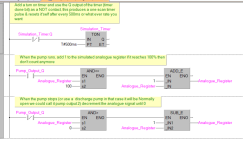No i don't have the sensor, i'm just learning PLC to aquire enoght knowledge to make a living out of it, the sensor i have mentioned is the kind used in factories as i know, i'm looking for ways to simulate inputes so i can learn more.It sounds like you already have a sensor, so why do it the hard way, as I said before although it may seem to work short term, over a long period just adding/subracting a constant based on a pump running it will go out of sync, a pump does not deliver a constant flow on startup & shut down & other possible interferences i.e. friction, pressure etc. the only other way is to have full & empty probes, that way when full or empty could use the probes to re-calibrate the levels.
In reality there is lot of interfrences must be considered







